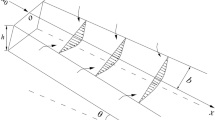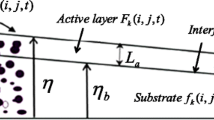Abstract
This study explores the influences of flow discharge and particle size on bedload transport trajectory by applying a depth-averaged two-dimensional model to a 110° sine-generated laboratory flume with wide-and-shallow sections. Calculated results exhibit two erosion regions in a bend: Zone-1—oreside of the point bar near the convex bank and Zone-2—near the apex of the concave bank. Sediments eroded from Zone-1 are mainly transported along the same-side convex bank rather than crossing the channel centerline, indicating the crucial role of longitudinal flow in shaping point bars. Most particles from Zone-2, however, behave more complicated by changing their trajectories with the developing bar-pool topography. Besides, sensitivity analyses indicate that, the shifting of bedload trajectory in the curved channel is not susceptible to particle size while considerably varies with flow discharge. Moving particles in a meandering channel are ultimately constrained within the belt of “concave bank‒crossing bar‒concave bank” after the bend topography is fully developed and the bed deformation reaches a dynamic equilibrium.







Similar content being viewed by others
REFERENCES
ASCE, River width adjustment. I: Processes and mechanisms, J. Hydraul. Eng., 1998, vol. 124, no. 9, pp. 881–902.
Balachandar, R. and Bhuiyan, F., Higher-order moments of velocity fluctuations in an open-channel flow with large bottom roughness, J. Hydraul. Eng., 2007, vol. 133, no. 1, pp. 77–87. https://doi.org/10.1061/(ASCE)07339429(2007)133:1(77)
Balachandar, R. and Patel, V.C., Rough wall boundary layer on plates in open channels, J. Hydraul. Eng., 2002, vol. 128, no. 10, pp. 947–951. https://doi.org/10.1061/(ASCE)0733-9429(2002)128:10(947)
Bolla Pittaluga, M. and Seminara, G., Nonlinearity and unsteadiness in river meandering: a review of progress in theory and modelling, Earth Surf. Processes Landforms, 2011, vol. 36, pp. 20–38. https://doi.org/10.1002/esp.2089
Chen, D. and He, L., Modeling sediment transport in sine-generated meandering channels, EWRI2013, Cicinati, USA, 2013.
Chen, D. and Duan, J.D., Simulating sine-generated meandering channel evolution with an analytical model, J. Hydraul. Res., 2006, vol. 44, no. 3, pp. 363–373. https://doi.org/10.1080/00221686.2006.9521688
Chen, D. and Tang, C.L., Evaluating secondary flows in the evolution of sine-generated meanders, Geomorphology, 2012, vol. 163(SI), pp. 37–44. https://doi.org/10.1016/j.geomorph.2012.04.010
Chen, D., He, L., and Liu, J., Experimental study on sediment transport in meander channels, AGU fall meeting abstracts, 2013.
Chien, N. and Wan, Z., Mechanics of sediment transport, Translated under the guidance of John S. McNown, ASCE Press, 1999.
Chien, N., Zhang, R., and Chou, Z.D., River evolution, Science Press, 1987.
Da Silva, A.M.F., Turbulent flow in sine-generated meandering channels, PhD Thesis, Queen’s Univ., Kingston, Canada. 1995.
Da Silva, A.M.F. and Ei-Tahawy, T., On the location in flow plan of erosion-deposition zones in sine-generated meandering streams, J. Hydraul. Res., 2008, vol. 46, no. S1, pp. 49–60.
Da Silva, A.M.F., El-Tahawy, T., and Tape, W.D., Variations of flow pattern with sinuosity in sine-generated meandering streams, J. Hydraul. Eng., 2006, vol. 132, no. 10, pp. 1003–1014. https://doi.org/10.1061/(ASCE)0733-9429(2006)132:0(1003)
Dolgopolova, E.N., The coefficient of friction in channel flow, Water Resour., 2000, vol. 27, no. 6, pp. 611–616.
Engels, H., Das Flussbau-Labora Torium DerkgL, Techni Schen Hochschule in Dresden, Berlin, 1900.
Friedkin, J., A laboratory study of the meandering of alluvial rivers, US Waterways Experiment Station: Vicksburg, 1945.
He, L. and Chen, D., Modeling curvature- and topography-driven secondary currents in sine-generated meandering channels, EWRI2013, Cicinati, USA, 2013.
Hooke, R., Distribution of sediment transport and shear stress in a meander bend, J. Geol., 1975, vol. 83, no. 5, pp. 543–566. https://doi.org/10.1086/628140
Huang, S.L. and NG, C.O., Hydraulics of a submerged weir and applicability in navigational channels: Basic flow structures, Int. J. Numer. Meth. Eng., 2007, vol. 69, no. 11, pp. 2264–2278. https://doi.org/10.1002/nme.1849
Huang, S.L., Jia, Y.F., Gao, G.H., Chen, Q.W., and Wang, S.S.Y., Numerical comparison of three- and two-dimensional model for modeling meandering channel flow, Proc. 35th IAHR World Congr., 2013, pp. 106–113.
Jia, Y.F. and Wang, S.S.Y., Numerical model for channel flow and morphological change studies, J. Hydraul. Eng., 1999, vol. 125, no. 9, pp. 924–933. https://doi.org/10.1061/(ASCE)07339429(1999)125:9(924)
Jia, Y.F., Wang, S.Y.Y., and Xu, Y.Ch., Validation and application of a 2D model to channels with complex geometry, Int. J. Comput. Eng. Sci., 2002, vol. 3, no. 1, pp. 57–71.
Kantoush, S.A., Bollaert, E., and Schleiss, A.J., Experimental and numerical modelling of sedimentation in a rectangular shallow basin, Int. J. Sedim. Res., 2008, vol. 23, no. 3, pp. 212–232. https://doi.org/10.1016/S1001-6279(08)60020-7
Mathes, G.H., Basic aspects of Stream Meanders, Trans. Amer. GeoPhys Union, 1941, Pt. 111.
Misiura, K. and Czechowski, L., Numerical modeling of sedimentary structures in rivers on Earth and Titan, Geol. Q., 2015, vol. 59, no. 3, pp. 565–580. https://doi.org/10.7306/gq.1236
Nassar, M.A., Multi-parametric sensitivity analysis of CCHE2D for channel flow simulations in Nile River, J. Hydro-Environ. Res., 2011, vol. 5, no. 3, pp. 187–195. https://doi.org/10.1016/j.jher.2010.12.002
Nezu, I. and Nakagawa, H., Turbulent in Open-Channel Flow, IAHR Monograph Series, Balkema, Rotterdam, The Netherlands: Taylor & Francis, 1993.
Rostami, M. and Habibi, S., Numerical simulation of local tributary widening impacts on hydro-morphological processes of river confluence using CCHE2D, River Flow 2014, 2014, pp. 1015–1023.
Rui, D.F., Numerical model for circumfluence and movement of sediment in continuous meandering river, PhD Thesis, Sichuan Univ., Sichuan, China, 2005.
Tena, A., Ksiazek, L., Vericat, D. and Batalla, RJ., Assessing the geomorphic effects of a flushing flow in a large regulated river, River Res. Appl., 2013, vol. 29, no. 7, pp. 876–890. https://doi.org/10.1002/rra.2572
Termini, D. and Piraino, M., Experimental analysis of cross-sectional flow motion in a large amplitude meandering bend, Earth Surf. Processes Landforms, 2011, vol. 36, pp. 244–256. https://doi.org/10.1002/esp.2095
Termini, D., Experimental observations of flow and bed processes in large-amplitude meandering flume, J. Hydraul. Eng., 2009, pp. 575–587. https://doi.org/10.1061/(ASCE)HY.19437900.0000046
Termini, D., Momentum transport and bed shear stress distribution in a meandering bend: Experimental analysis in a laboratory flume, Adv. Water Resour., 2015, vol. 81, pp. 128–141. https://doi.org/10.1016/j.advwatres.2015.01.005
Thomson, J., On the flow of water round river bends, Proc. Inst. Mech. Engineers, August 6, 1979.
Wang, B., Experiments of water flow and bed deformation in a flume with consecutive curves, PhD Thesis, Tsinghua Univ., Beijing, China, 2008.
Whiting, P.J. and Dietrich, W.E., Experimental constraints on bar migration through bends—implications for meander wavelength selection, Water Resour. Res., 1993, vol. 29, no. 4, pp. 1091–1102. https://doi.org/10.1029/92WR02356
Whiting, P.J. and Dietrich, W.E., Experimental studies of bed topography and flow patterns in large-amplitude meanders, 1. Observations, Water Resour. Res., 1993, vol. 29, no. 11, pp. 3605–3614. https://doi.org/10.1029/93WR01755
Wu, W.M. and Wang, S.S.Y., Movable bed roughness in alluvial rivers, J. Hydraul. Eng., 1999, vol. 125, no. 12, pp. 1309–1312. https://doi.org/10.1061/(ASCE)0733-9429(1999)125:12(1309)
Wu, W.M., Wang, S.S.Y., and Jia, Y.F., Nonuniform sediment transport in alluvial rivers, J Hydraul. Res., 2000, vol. 38, no. 6, pp. 427–434. https://doi.org/10.1080/00221680009498296
Yalin, M.S., River mechanics, Oxford: Pergamum Press, 1992.
Zeng, Q.H., Bottom sediment problems in curved channels, J. Sediment. Res., 1982, vol. 3, pp. 59–65.
Zhang, H.W. and Lv, X., Bend hydraulics, Beijing: Water Conservancy and Electric Power Press, 1993.
Zhang, R.J. and Xie, B.L., Study on river meander laws, 1st Int. Sympos. River Sedimentation, 1980, vol. 1, pp. 427–436.
Zhuang, J., Zhang J., Huang, D., Zheng, G., and Lai, G., On the characteristics of flow movement in the bending and bifurcated river, Adv. Water Resour. Hydr. Eng., 2009, vols. 1–6, pp. 307–316. https://doi.org/10.1007/978-3-540-89465-0_151
FUNDING
This study partially supported by (1) National Key R&D Program of China (2017YFC0405203) (2) National Natural Science Foundation of China (Nos. 51 579 230, 41 571 005, 51 109 198, 51 279 192, 51509234, 51 779 242, and 41 330 751), and the “Hundred Talents Program” of Chinese Academy of Sciences is gratefully acknowledged. This paper does not necessarily reflect the view of the funding agencies.
Author information
Authors and Affiliations
Corresponding authors
Rights and permissions
About this article
Cite this article
Li He, Chen, D., Termini, D. et al. Modeling Bedload Transport Trajectories along a Sine-Generated Channel. Water Resour 46, 542–552 (2019). https://doi.org/10.1134/S0097807819040134
Received:
Revised:
Accepted:
Published:
Issue Date:
DOI: https://doi.org/10.1134/S0097807819040134




